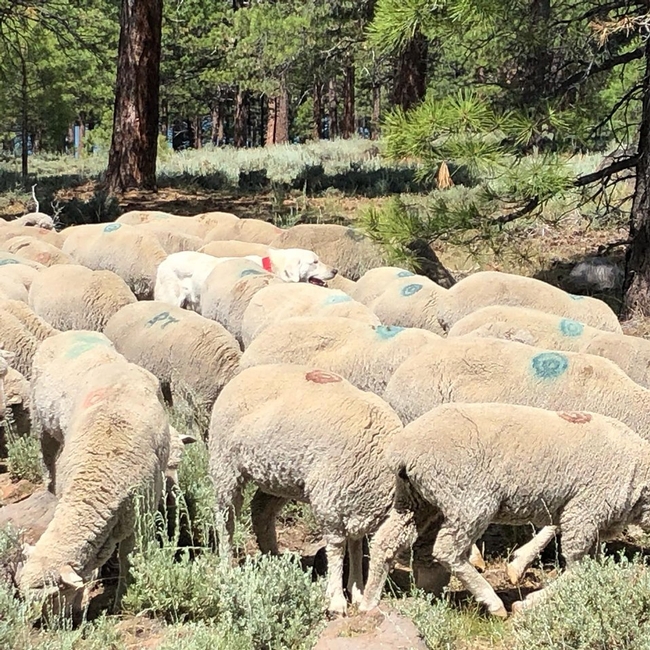One of the questions I'm asked most frequently when it comes to livestock guardian dogs is, "How many dogs do I need to protect my sheep/goats/cows?" As you might imagine, the short answer is, "It depends." The long answer is more complex. From an economic perspective, the answer is, "As many as it takes to hold predator losses in your operation at an acceptable level, but no more than that." From a production perspective, I've found that the answer depends on operational characteristics, the environment, and the abilities of the specific dog(s).
While it is tempting to try to develop a rule of thumb recommendation (like one dog per 100 ewes), reality is usually more complicated. Wearing my sheepherder economics hat for a moment, the fundamental question comes down to comparing the costs of a dog versus the benefits the dog provides. On the cost side of the ledger, I must account for the cost of dog food, veterinary care, and depreciation. In our operation, these annual expenses amount to roughly $600 per dog. On the benefit side of the ledger, I need to know how many sheep DON'T get killed by predators to determine if my $600 in expenses are justified. Obviously, this is not an easy number to estimate - how can I measure something that doesn't happen? How do I quantify the sheep that might have died had I not had a livestock guardian dog with them? I suspect we'd lose more sheep if we didn't use dogs, but I'm not willing to leave the sheep unprotected to find out!
Operational characteristics, in my experience, play a significant role in determining the optimal number of dogs. Birthing seasons (spring vs. fall), other livestock protection tools (like electric fence, on-site herders, night penning, etc.), grazing management (set stocking versus rotational grazing), and the number of individual herds or flocks all factor into determining the right number. Using our operation as an example:
- We lamb in the late winter and early spring, when there is not a significant natural prey base for the wild predators in our environment. Our lambing paddocks are 7 miles from our home. This argues for more dogs.
- We use electro-net fencing, which definitely deters canine predators (dogs, coyotes and foxes) as well as bobcats. This allows us to get by with fewer dogs.
- We move the sheep frequently - they move to fresh pasture every few days, and graze different properties in spring/summer versus fall/winter. I suspect all of this movement keeps the predators off balance. This allows us to get by with fewer dogs.
- We rarely (if ever) have all of our sheep in one mob. This time of year, the mature ewes are in one flock; the feeder lambs and replacement ewe lambs are in a second flock; the rams in a third location. During breeding season, we have two separate breeding groups plus a group of lambs. This argues for more dogs.
Based on these factors, we feel that we need at least three dogs for our small, part-time operation. With three dogs, we can protect three different groups of sheep or place two dogs together during our most vulnerable time of year (lambing). During some parts of the year, we have more dogs than necessary, which provides flexibility if we begin to have problems with predation.
The environment where we're grazing, and the predators it contains, is a second critical consideration. Here in the Sierra foothills (at least at the moment) our main predators (in order of potential threat) are domestic dogs, coyotes, mountain lions, black bears, bobcats, foxes, and birds of prey. I've spoken with ranchers on the north coast who would add crows, ravens, and magpies to that list. And ranchers in northeastern California would add gray wolves. Predator density and prey base also come in to play. Are there several established packs of wolves in the region? Is there sufficient native prey? Are these particular wolves (or coyotes, or mountain lions) known to prey on livestock? Each of these questions are important to consider when determining how many dogs a particular operation might need.
Finally, every livestock guardian dog is an individual. Some are athletic and want to patrol a wide area; others want to stay with their livestock. Some dogs are more canine aggressive than others (an important trait in wolf habitat); others will harass bears. And these traits will change over time - a dog that was aggressive and athletic in his younger days might be content to stay with lambs on irrigated pasture in his later years. In my experience, there is more variation between individuals than there is between livestock guardian dog breeds (a subject for a future blog post!).
Finally, I started a new phase of my livestock guardian dog behavior study this week. I'll be tracking the movements of four dogs (2 each in separate 1000-ewe bands of sheep) grazing on the Tahoe National Forest in Nevada and Sierra Counties (in an area that a collared Oregon wolf has been known to visit in the last 12 months). This is a long-time producer with experienced herders operating on open range with no fences. They typically use two dogs with one band and three dogs with the other, and experience less than one percent death loss while the sheep are on Forest Service allotments. They also have additional dogs they can add to each band if predator problems begin to escalate.
I think this illuminates the "it depends" answer in my first paragraph! They have 1 dog per 400 sheep; we have 1 dog per 51 sheep. They are grazing mature ewes in a relatively wild environment for only 75 days - and at a time when the natural prey base is plentiful. We need more dogs to protect ewes and lambs at an especially vulnerable time of year (and I should note - the large operation needs more dogs at lambing as well). The common thread for each of these operations, however, is that we are constantly evaluating our need for predator protection against the cost of providing it. If we could get by with fewer dogs, we would; similarly, if the large operation needs more dogs this summer, they'll add dogs. In other words, it depends!

